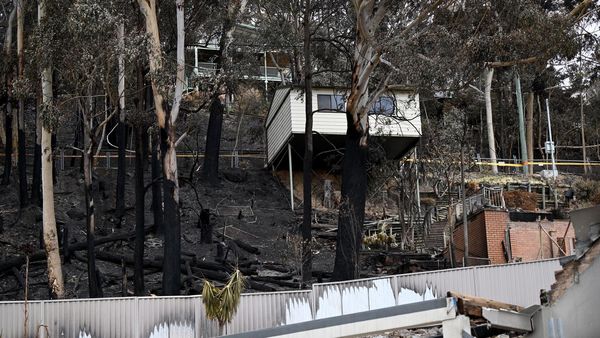
More than 14,000 volunteer soldiers from across Canada – fighting alongside British and US troops – seized the beaches of Normandy on D-Day to help liberate the region from German occupation. Eighty years since that fatal day in June 1944, a handful of local inhabitants have made it their mission to preserve and pass on the lesser-known stories of Canadian soldiers.
At the break of dawn on June 6, 1944, more than 14,000 Canadian soldiers landed or parachuted on Juno Beach – a 10-kilometre stretch of French coastline in Normandy. Their objective was simple, albeit deadly. Braving intense fire from German defenders, these volunteer servicemen were to take back control of the beach and move inland to liberate the city of Caen from Nazi occupation.
After over a month of intense and bloody fighting in an area that barely covers more than 20 kilometres in total, Canadian and British Allied forces finally liberated Caen on July 9, 1944.
A total of 359 Canadians were killed on D-Day alone and more than 5,000 lost their lives during the Battle of Normandy. Most of them have been laid to rest just a few metres from the battlefields, in two separate cemeteries.
As Normandy gears up to commemorate the 80th anniversary of the D-Day landings on June 6, final preparations are being made at one of the Canadian cemeteries to pay special tribute to these fallen soldiers.
“The watchword this year is ‘transmission’ – passing on to future generations,” says Carl Liversage, who is in charge of the commemoration preparations, as he strolls between the aisles of the flower-decked graves he knows by heart.
“Fifteen Canadian veterans will take part in this year’s event. But we are well aware that they may be the last remaining witnesses and will soon no longer be with us,” he explains. “So we have to pass the baton of remembrance on to the younger generation.”
French and Canadian schoolchildren are playing a major role in the ceremonies this year. Between June 4 and 6, a thousand students from Normandy and several hundred Canadian pupils will light 25,000 candles to be placed on graves across Commonwealth cemeteries in the region. Others will read poems and texts written in tribute to the fallen soldiers. “They will, in turn, become those who keep the memory alive,” Liversage says.
Applauded by local mayors, the initiative has become a source of pride. “Our history and that of the Canadians are intertwined. We feel very strongly about that here in Normandy. So it is important that young people learn about that shared history, that they know the stories of these soldiers and that their names live on,” says Reviers mayor Daniel Guérin, whose commune is home to Juno Beach.
‘I will remember that day for the rest of my life’
Aside from organising the annual commemoration events, people like Liversage and Guérin have also worked every day to ensure that the memory of Canadian soldiers who took part in D-Day is kept alive.
So has Michel Le Baron. Despite his frail health, this 90-year-old Normandy native makes a point of telling his story to anyone who will lend an ear. Le Baron was only 10 years old on June 6, 1944. “I was at boarding school right in the centre of Caen. The other pupils and I hid under some tables in the canteen,” he recalls. He remembers “the noise, the rumblings” of the Allied strikes and his “incomprehension” as a child.
At the height of Operation Overlord, Le Baron left school a few days later and headed back home under a sky of “bombs and war planes”. Back home, he had to learn to live with the Germans, who occupied part of his house. “When you are just 10 years old, that stuff marks you,” he says with a wry smile.
Although he admits his memories are “hazy”, one moment in particular has stayed with him throughout his life. “One evening, a pilot fell from a plane with his parachute, right in the middle of the countryside,” he recounts. “We all saw it happen, civilians and soldiers alike.” His father knew the area like the back of his hand and was the first to find the soldier. After helping him, he decided to hide him.
Read moreWorld War II veterans leave their children a legacy of trauma
At first, the location was secret. But like all curious children, Le Baron eventually followed his father to the hiding place. “I will remember that day for the rest of my life,” says Le Baron. “My father said, ‘Do you remember the pilot who fell? He is here now. He is a Canadian soldier. We are going to help him but you must not tell anyone, not even your mother.’”
The Canadian soldier eventually survived Operation Overlord, largely thanks to Le Baron and his father, with whom he stayed in touch for the rest of his life. “That is what made me decide to devote my life to honouring the memory of Canadian D-Day soldiers,” beams Le Baron, who went on to become mayor of Cintheaux, where one of the two Canadian cemeteries is located.
“Back in the early 1970s, it was the largest Canadian military cemetery in the world [with 2,874 Canadian soldier gravestones]. Yet it was completely forgotten during national commemorations,” he says. Determined to change things, Le Baron decided to organise a Canadian ceremony – the first of many.
“Canada paid a heavy price. Soldiers who fought during Operation Overlord were very young and the vast majority of them were volunteers. We owe it to them to tell their stories and keep their memory alive,” he insists.
Over the past 50 years, Le Baron has organised dozens of commemorations and tributes to Canadian soldiers, and has shared his story with thousands of schoolchildren.
A tribute centre for Canadians
Le Baron also helped establish the Juno Beach Centre. Inaugurated in 2003, it is the only centre in the world entirely devoted to the role Canadians played during World War II and took almost ten years to be built. “The project was the brainchild of a Canadian veteran, Garth Webb, back in 1994,” explains Catherine Quintal, one of the centre’s managers. “He wondered what he could show his children and grandchildren in Normandy while telling his story, and that is how he came up with the idea of a Canadian museum.”
The desire for transmission was also at the origin of Webb’s idea to employ young Canadians as museum guides. Every year, seven young people from across Canada are hired to walk through the space with visitors, look back at the history of the country’s involvement in World War II and the lasting impact this had on its society.
“I came to Juno Beach ten years ago with my family. It was a real turning point for me. I became passionate about history and it was my dream to come work here,” says Olina, 22, after giving a tour of a former bunker a few steps away from the centre. The British Columbia native is part of this year’s team, hired to work at the museum until September. “In Canada, we all know at least one person who knows someone who died during World War II. It is very important for me to tell people about what happened here, especially young people.”
A Canadian family home, the first house to be liberated
Further down along the coastline, a beautiful house with Canadian flags hanging from the windows catches the attention of a few tourists. Standing at the open doorway, Nicole Hoffer offers a broad smile.
Hoffer and her husband turned the typically Norman holiday home into one of the most important meeting points for Canadian veterans and their families. According to old soldiers' tales, the house was the first to be liberated by Allied forces arriving on Juno Beach back on June 6, 1944.
“The house belonged to my late husband’s grandparents, who had owned it since 1936. From 1942 onwards, the Germans occupied it. And that was very fortunate,” says Hoffer, “Because it was inhabited, the Germans had orders not to destroy it. And the Allied forces had the same orders. The house was the first one visible from the open sea, so it was a great way for soldiers to find their bearings.”
The Hoffer family regained ownership of the family home after the war. Damaged but still standing, its history remained a mystery for a long time. It was not until the 1980s that the true story about what happened came out. “I was amazed because I kept seeing people, sometimes in tears, stopping to take photos of the house. But nobody in the family could explain why. I ended up asking a group of Canadian veterans who told me, ‘That is our house! We landed here and liberated it.’ That is when we learned that our house was actually an historic symbol,” Hoffer explains.
From that moment onwards, the family made it their mission to open "Canada House" to the public. Over the years, the Hoffers have forged friendships with veterans and their families.
Thanks to generous donations, the living room has now been transformed into a real-life museum. Each object displayed tells a story. A painting of D-Day made by a veteran, an old Morse code telephone, medals and even an old banknote that allowed a German soldier to pay for his survival.
“Families have often told us that it is thanks to coming here that their fathers, uncles or brothers begin to speak out about their experiences,” Hoffer says. “And it has always been very powerful for us to meet these witnesses to history.”
“At first, I was often criticised for opening my door to strangers. But we owed it to them. They came and liberated us,” she concludes.
With fewer and fewer veterans knocking on her door, both "Canada House" and the D-Day commemorations are taking on new dimensions. Nowadays, it is mostly schoolchildren who come to learn about the history that took place between these four walls. “It is no longer just a question of paying our respects,” says Hoffer. “It is about passing our stories on to children so that our memories don’t die with us.”
For the 80th anniversary of D-Day on June 6, as is the case each year, Hoffer will host a lantern ceremony. “A few days before we will light a lantern, and on the evening of June 6, we will bring the flame of freedom out to sea. We will hand out flowers to all those taking part, so they can lay them down while bagpipes play in the background,” she says.
‘Their stories live on’
Ardenne Abbey, a former monastery, is also an iconic site for Canadians. But its history is much darker than that of "Canada House". Gabrielle Vico, the owner of the estate situated directly opposite the abbey, has been telling it for more than 60 years.
It was at Ardenne Abbey that Kurt Meyer, an SS commander, set up his headquarters. It was also here that 20 Canadian soldiers were captured and executed on June 7 and 8 of 1944, as intense fighting to liberate nearby Caen raged on.
Sitting in her wheelchair in one of the abbey's sitting rooms, Vico tells the story of what happened. The family returned to the estate after the Germans left in August 1944. Then in early 1945, “my husband Jacques and his brothers began finding bodies”, explains Vico.
“The two youngest brothers noticed that the soil at the foot of a small chesnut tree has been tampered with. They dug until they came across a buried soldier,” she recounts solemnly. One macabre discovery led to another. “In May 1945, my husband asked a radiesthesist [person who claims they can detect radiation emitted by beings or objects] to examine the area. Two new bodies were found,” she continues.
A total of 19 bodies were unearthed on the estate. One is still missing today.
Read moreThe Wrens, unsung British heroines of the D-Day landings in Normandy
Until the 1980s, these 20 victims were “just names on a memorial stone”. But things changed when a Canadian officer, Ian J. Campbell, visited the abbey. “He decided to research the lives of each of the soldiers and write a book about them. My husband continued his work and translated large parts of the book into French,” she explains. “When [my husband] died, I decided to use information from the book to make signs and brochures explaining who these soldiers were. They regained their identity and now their stories live on,” she smiles.
Despite being almost 100 years old, Vico still crosses the street every day to fill pigeonholes with brochures. She recounts the story of what happened at the abbey to schoolchildren and, just like Hoffer and Le Baron, underlines the importance of intergenerational transmission. “Canadian soldiers played such an important role. They helped liberate us! We owe it to them,” she says.
This article has been translated from the original in French.







